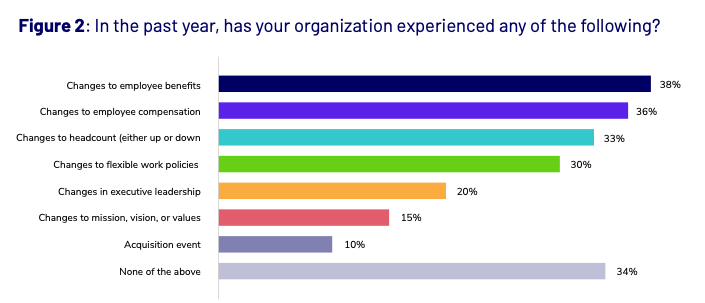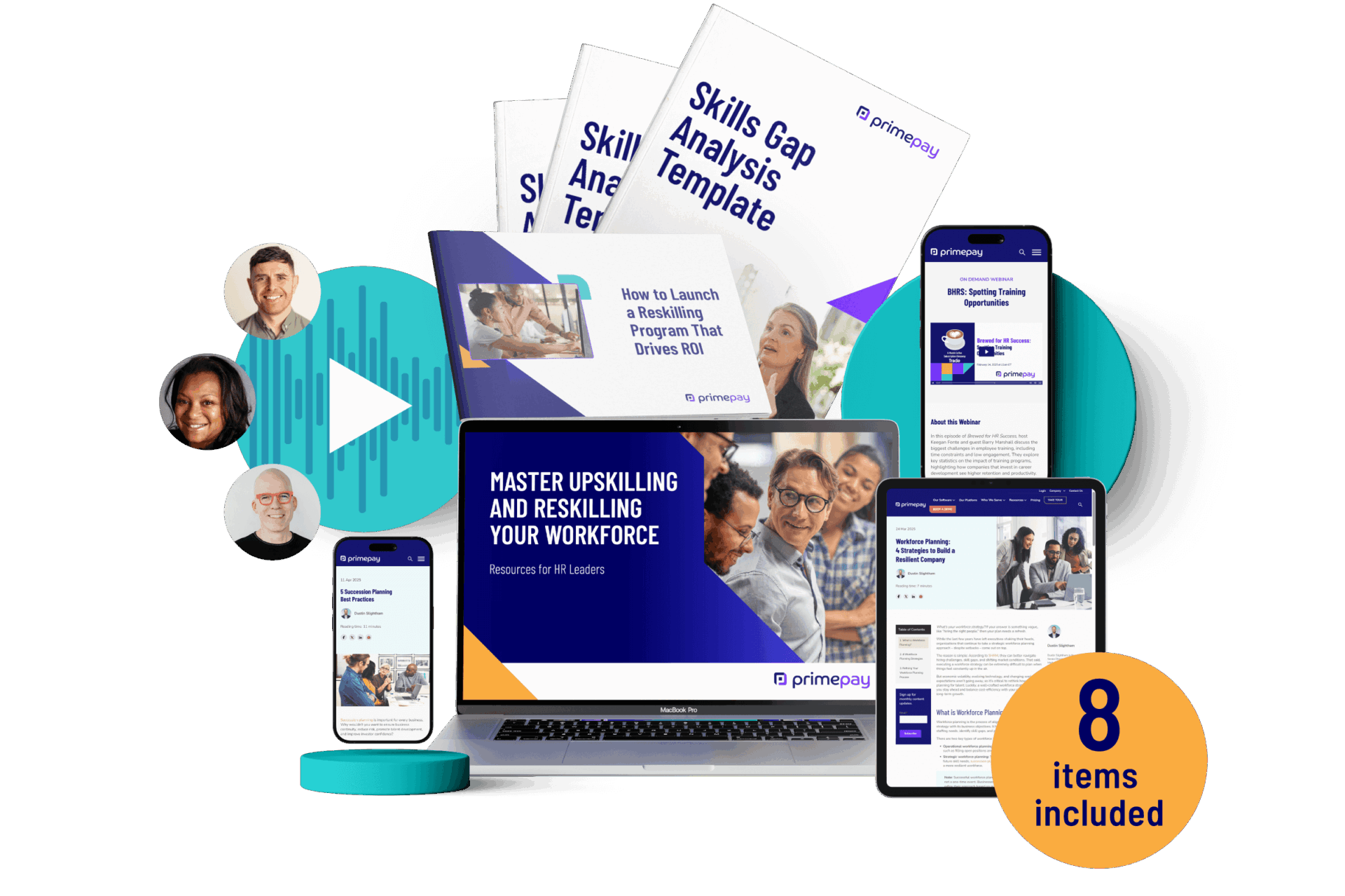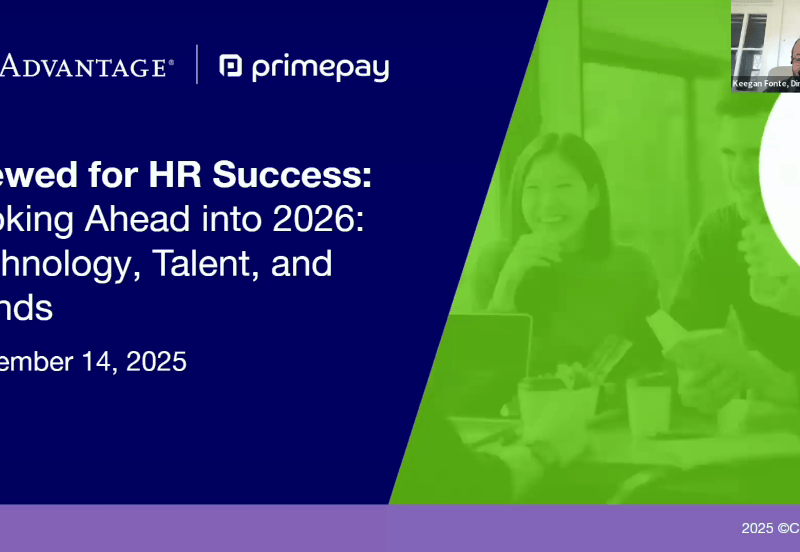Imagine this: Your company is thriving…or so it seems. The office buzzes with activity, yet subtle signs of discontent are growing beneath the surface. Key projects are stalling, and talented employees are quietly heading for the door.
What went wrong?
The answer lies in the unseen gaps—those moments when employee feedback wasn’t collected, data wasn’t analyzed, and voices were left unheard.
Shockingly enough, only 53% of HR leaders gather employee feedback quarterly, meaning almost half of companies don’t use employee insights regularly to improve practices. Regular data collection empowers you to see storms brewing and make much-needed adjustments to enhance the employee experience before situations like these unfold.
Without employee experience analytics, you’re not only left in the dark about how employees feel but also whether they understand their purpose and role within the company.
Data is the Future of Employee Experience Practices
Data is a powerful tool to drive strategic decisions and enhance people management.
In HR, some of the primary uses of data include:
- Recruitment
- Performance
- Compensation and benefits
- Retention
By analyzing trends and metrics, HR teams can identify better ways to recruit and train employees, improve benefits, and create roadmaps for the future.
However, HR often overlooks gathering employee data on engagement, understanding of role purpose, and alignment with company goals.
Employee experience and engagement statistics allow HR to determine these crucial factors. By leveraging this data, HR teams can develop targeted plans for improvement in the right areas, ensuring employees feel valued, understood, and connected to the company’s mission.
5 Best Practices for Collecting and Using Employee Experience Data
Need help with how to use data to create a better employee experience? Below are five ways to ensure you capture (and act on) accurate and timely employee insights.
1. Hone in On Employees’ Understanding Of Strategy And Metrics
Employee engagement is crucial from day one. From the moment new hires are onboarded, it’s vital to establish a strong connection and clear understanding of their purpose within the organization.
This initial phase sets the tone for their entire journey, ensuring they see how their role contributes to the company’s overarching goals. HR teams must act swiftly to cultivate this engagement and lay the foundation for employees’ long-term success.
However, this ideal scenario isn’t always reality. Less than half of employees report understanding their role or what’s expected of their team or department, and only 45% of employees clearly understand how their role relates to their company’s mission. Ensuring employees understand what they do daily (and how it ties into the company’s objectives) is strongly connected to productivity, retention, and the overall employee experience.
On the other hand, disengagement arises when employees need clarification of their role and purpose. Human Capital Executive Lorna Hagen states: “Dissatisfaction and disengagement happens when you don’t know why you’re doing something. Right? It’s a definition of insanity. I show up every day, and I have no idea what we’re doing here.”
Long story short, collecting employee experience analytics allows you to peek behind the curtain to see how well employees grasp their roles and use the information to correct the course if needed.
However, Hagen admits that data is an area for improvement for most HR teams. She explains: “We don’t do enough collection of feedback on employee understanding of company strategy and company metrics. I absolutely believe that a disengaged employee starts because they don’t understand why they’re there.”
Practical Tip: Regularly Deploy Employee Feedback Surveys
Frequent data collection is the linchpin for uncovering and addressing employee disengagement, role confusion, and whether employees are aligned with company goals. However, many companies don’t gather enough data – only 20% of companies collect employee experience data frequently.
Hagen lists this as one of her biggest regrets, admitting that she wishes she “had collected more and […] over-indexed my surveys on understanding the business and the business gaps, meaning the gaps in how work gets done.”
Her reflection offers an approach involving frequent employee feedback surveys to gather detailed data. These surveys provide deep insights into employees’ understanding of their roles and purpose and how these elements coincide with company objectives.
2. Combine Employee Feedback Surveys With Human Interaction
Employee feedback surveys are excellent tools for gaining insights into how employees perceive and feel about your company. They enable you to make actionable decisions based on data.
Lisa Parks, managing partner and General Counsel at McDougal Advisors, explains, “Gathering feedback through surveys is great when you want to gather a bulk of feedback at once and maybe get at something employees aren’t comfortable saying one-on-one or reporting to HR.”
However, surveys are only one piece of the puzzle. While surveys allow you to see how employees feel as a group, they may not capture the nuances of each individual’s experience.
Another critical factor to consider is the message the analytics convey and whether it aligns with how employees genuinely feel and think. Surveys alone don’t always reveal the full scope of what the data is saying or how it looks in real life.
Parks emphasizes this point with an example: “A billability report might show you how stressed out you think employees are and how overly full their plates are. But without the context of what that actually feels like on a day-to-day basis, it could be very different depending on the type of work or the type of clients.”
The discrepancy between what data says and how employees genuinely feel highlights the importance of complementing survey data with deeper, context-rich insights from individual conversations and observations.
Practical Tip: A Holistic Look At Employee Insights
Human interaction alongside data collection is essential to fully understanding what’s happening in the workplace. Parks strongly favors one-on-one conversations with front-line managers to gain the context she needs and close the information gap.
She states, “That human gathering of information in a trusted relationship is always going to be, for me, the gold standard of what’s really going on and what I trust the most.”
Combining the insights gathered from these personal interactions with the data collected from surveys provides a comprehensive understanding of your people. This two-pronged strategy empowers you to create an actionable plan that addresses both the broader trends and the individual experiences of employees.
3. Leverage Data For Business Impact
Have you ever wanted your CEO or CFO to sign off on a new initiative or program, but they wouldn’t budge?
Start-up expert Barry Marshall points out the importance of data in these situations: “When you want to invoke programs or initiatives or take action, our CEOs and CFOs don’t listen to conjecture and presumptions. They want data. We need data to speak and basically be that voice of the people through the lens of data to drive direction and business impact.”
To provide CEOs and CFOs with the data they need to make solid decisions, you must balance employee experience surveys with targeted and insightful questions that offer invaluable employee insights. This approach not only captures the pulse of employees but also generates the evidence required to launch new programs and initiatives.
Practical Tip: Track and Analyze Employee Experience Analytics
For the best impact, asking insightful questions that collect quality data and track it over time is crucial. Rather than overwhelming employees with many questions each month, focus on asking meaningful questions that get down to the base level of the issue.
Marshall suggests, “Find ways to ask really good questions that get at the heart, the root of the why, and just watch it over time as things begin to change.”
Integrating manager-collected data with insights from one-on-one conversations can increase the quality of your results. By combining these sources of information, you can gain a better perspective of your company’s workplace engagement and cultivate an effective action plan.
Moreover, having robust, tracked data provides the evidence you need to present to CEOs and CFOs.
4. Adapt To Dramatic Organizational Change
Reports and workplace engagement insights allow you to gain a pulse check, especially after organizational changes. With 64% of HR leaders reporting dramatic changes, it’s clear that numerous companies, from tech giants to small- and medium-sized businesses, have undergone significant shifts.
Organizational changes aren’t the only times to check in with employees and managers.
Whenever you:
- Downsize
- Increase headcount
- Start a new initiative
- Shift strategies
Or make changes in:
- Benefits
- Compensation
- Leadership
- Company mission, values, and goals
…it’s vital to collect feedback and data from all major and minor changes to the company. The key is to understand the impact, whether positive or negative.
Conducting employee engagement surveys and having one-on-one conversations provides access to this crucial information. Regularly gathering feedback ensures you understand employees’ sentiments during transitional moments.
Parks advises, “Collecting feedback after communications is crucial because the information hits differently depending on the employee.”
By staying attuned to employee sentiments through regular feedback, you can navigate organizational changes effectively.

Change is the new norm for most organizations. Read our 2024 State of Employee Experience research report, filled with company and employee insights, to help transform your own employee experience program.
5. Maintain Employee Engagement During Transitions
To maintain employee engagement and morale during transitional times, Marshall emphasizes, “Communicate, communicate, communicate.” Clearly articulate the reasons for the change, the expected outcomes, and how it will impact employees.
Parks recommends considering the following three questions before making any announcements of change:
- What are they expecting to hear?
- What do they want to hear?
- What are they afraid to hear?
She warns, “We can tend to shy away or not want to address the ‘what are they afraid to hear,’ and that’s such a mistake.”
Transparency fosters trust and helps alleviate anxiety and uncertainty. Regular updates and open forums where employees can ask questions and express concerns are essential, yet only 26% of organizations provide open forums like town halls and all-hands meetings.
Communication has to be a two-way street to maintain engagement and morale. People leaders must communicate effectively, early, and often, and employees should feel comfortable and open to relay their thoughts and concerns about what’s to come or what’s happening.
Open communication creates an environment where employees feel informed, valued, and heard. This mitigates the stress associated with transitions and strengthens the overall sense of community within the organization.
Elevating Employee Experience Through Data Collection
Data collection is integral to the future of employee experience. It empowers HR leaders to enhance the overall work environment by enabling informed decisions, identifying trends and issues early on, and providing insights for personalized employee engagement.
With data, organizations can measure the impact of their initiatives, refine communication strategies, and adapt to changing circumstances. Today’s workplace constantly evolves, and leveraging data is paramount for maintaining a positive and dynamic employee experience.
Prioritize regular employee feedback and data collection to ensure your strategies remain responsive, supportive, and effective.










